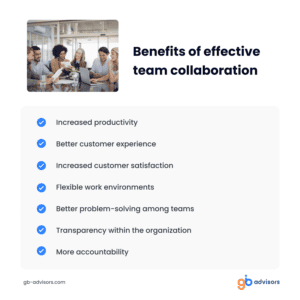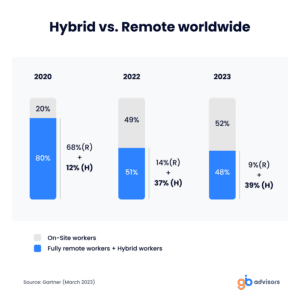Team collaboration is a relevant part of remote work setups.
Why? Because it helped organizations sustain growth in a challenging context like the pandemic.
However, in 2023 the hybrid mode is gaining ground in organizations worldwide.
In this blog, we will discuss the role of collaboration in the success of remote and hybrid work in organizations.
Moreover, we will talk about the challenges teams face to collaborate effectively.
Why is team collaboration essential in remote or hybrid work?

4 challenges that impede remote or hybrid team collaboration
1. Ineffective communication between teams
One of the challenges of team collaboration in hybrid and remote work in organizations is the communication between collaborators and areas.
What are the signs of ineffective communication dynamics among your teams?
Lack of clarity in the objectives and roles within the teams: A clear definition of objectives and roles of collaborators is necessary for teams to achieve their goals effectively.
Confusing communications: In this case, employees do not know the use of asynchronous or synchronous communication. Also, the use of multiple mediums to communicate scatter communication flow; as a result, some responses take longer than expected.
Inconvenient feedback sharing: Remote and hybrid work makes providing real-time feedback on any issue complex.
Ineffective meetings: Unexpected meetings with no clear objectives or stipulated duration are common among teams.
What are the consequences of perpetuating ineffective communication in teams?
Among the countless consequences, we can highlight:
- Unclear and, therefore, inefficient processes.
- Disrespected project deadlines.
- Increased burnout among employees due to constant improvisation.
- Managers can’t be aware of everything that is happening.
How can this be solved?
A key to facing this challenge is to have a platform that integrates communication channels (MS Teams, Slack, or email).
This way, all collaboration between collaborators can occur in one place, increasing transparency and establishing a single source of truth.
In addition, this allows your employees to save time when searching for information or requesting it.
Everything they need is just a few clicks away. As a result, managers and collaborators won’t have to spend hours searching in multiple places for data.
2. Isolated information
Another challenge of remote and hybrid work concerning team collaboration is isolated information.
Remote and hybrid dynamics have pushed teams to rely on technology to communicate with each other and other groups within the organization.
But what happens when the existing communication channels don’t provide a free path to carry out activities involved in collaboration?
One of the things that would happen is that there will be many “sources of truth” with too many communication channels being used simultaneously.
Moreover, collaborators will need help in document management, giving/receiving feedback, approvals, or activity tracking.
Also, teams will spend a significant portion of their workday gathering information.
All of this can hinder the development of their activities in case this lost information is critical to their processes.
All this translates into decreases in team performance and creates more room for improvisation, which can result in increased employee burnout.

How can this be solved?
The problem of isolated information is solved by centralizing the management of this information through software tools.
Your teams must have everything they need to collaborate in a single tool.
This tool should allow them to easily share files, share feedback, give/receive approvals, or track activities.
This does not mean they must discard essential communication tools like instant chats like MS Teams.
The platform where collaboration is centralized must be able to integrate this instant messaging and even official channels such as emails.
3. Inefficient resource management
Managing project resources (human, economic, assets) is critical to project performance and organizational performance in general.
In the case of project management, how can you know the availability of agents to work on a new task, or who is responsible for the activities being carried out?
How can you know the status of each task within the project and have access to all the information without spending hours searching for data in email threads, chats, and other tools?
All this information is crucial to have an overview of a team’s work and how they are investing efforts.
Having easy access to this data will facilitate, for example, human talent management.
This will make it easier to assign employees to tasks and areas where their help is needed.
As a result, team collaboration will be more fluid. Why? Because resources will be placed where they are needed to achieve the objectives.
How do you solve this?
Regarding resource management, one solution is to rely on software tools that offer a 360° view of everything that happens.
It is vital to move from spreadsheets to a tool that allows you to:
- Record and monitor the processes under development.
- Know who is in charge of what.
- What is the load of each collaborator?
- Development activities.
4. Uncommitted employees
In contexts of general uncertainty, organizations must protect themselves by seeking to be sustainable through efficiency.
This efficiency is not only about making more significant investments in technology.
It is also about empowering employees’ talent by improving their experience and making it easier for them to be more involved and rooted in the organizational culture.

How can you have more engaged employees?
- A robust organizational culture that prioritizes their experience.
- Adoption of technology initiatives that empower human talent.
Companies must combine an organizational culture that prioritizes employee well-being.
In addition, they must seek transparency and process efficiency, all enhanced with technological initiatives.
This is the only way companies can take advantage of hybrid or fully remote workforces.
How can this be solved?
One of the keys to overcoming this challenge lies in the organizational culture established among employees.
This culture must prioritize employees’ experience through technologies that improve processes from efficiency.
This will reduce the chances of employees suffering from burnout. As a result, you will make employees more comfortable with their roles, which also influences their commitment to the organization.
Adapt your organization to hybrid or fully remote environments.
Team collaboration is vital to the success of any area within an organization, especially in hybrid and fully remote settings.

However, to ensure that it happens without hindrance, organizations must be able to continue to rely on the technology that has facilitated it over the past two years.
They must also be able to build organizational cultures that consider issues such as balancing work and personal aspects of employees’ lives.
Remote work has increased the sense of connection between employees and their jobs, which increases burnout and dissatisfaction with their roles.
This translates into employees who are less committed to the organization and more likely to resign.
In this context in which hybrid work is making a comeback in employees’ lives, it is necessary to take advantage of it.
How to create it? By creating organizational cultures that make more efficient use of the technological tools that remote work has popularized.
In addition, it is necessary to continue to rely on technology. However, the economic sustainability of these efforts must be considered, as well as the employees who will take advantage of them.



